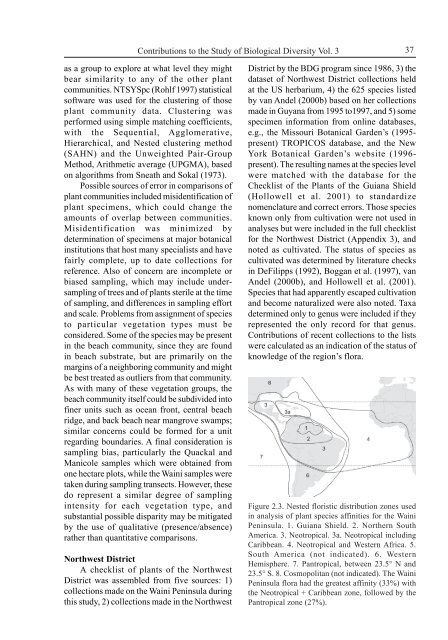Plant Community Structure, Fire Disturbance, and Recovery in ...
Plant Community Structure, Fire Disturbance, and Recovery in ...
Plant Community Structure, Fire Disturbance, and Recovery in ...
Create successful ePaper yourself
Turn your PDF publications into a flip-book with our unique Google optimized e-Paper software.
Contributions to the Study of Biological Diversity Vol. 3<br />
as a group to explore at what level they might<br />
bear similarity to any of the other plant<br />
communities. NTSYSpc (Rohlf 1997) statistical<br />
software was used for the cluster<strong>in</strong>g of those<br />
plant community data. Cluster<strong>in</strong>g was<br />
performed us<strong>in</strong>g simple match<strong>in</strong>g coefficients,<br />
with the Sequential, Agglomerative,<br />
Hierarchical, <strong>and</strong> Nested cluster<strong>in</strong>g method<br />
(SAHN) <strong>and</strong> the Unweighted Pair-Group<br />
Method, Arithmetic average (UPGMA), based<br />
on algorithms from Sneath <strong>and</strong> Sokal (1973).<br />
Possible sources of error <strong>in</strong> comparisons of<br />
plant communities <strong>in</strong>cluded misidentification of<br />
plant specimens, which could change the<br />
amounts of overlap between communities.<br />
Misidentification was m<strong>in</strong>imized by<br />
determ<strong>in</strong>ation of specimens at major botanical<br />
<strong>in</strong>stitutions that host many specialists <strong>and</strong> have<br />
fairly complete, up to date collections for<br />
reference. Also of concern are <strong>in</strong>complete or<br />
biased sampl<strong>in</strong>g, which may <strong>in</strong>clude undersampl<strong>in</strong>g<br />
of trees <strong>and</strong> of plants sterile at the time<br />
of sampl<strong>in</strong>g, <strong>and</strong> differences <strong>in</strong> sampl<strong>in</strong>g effort<br />
<strong>and</strong> scale. Problems from assignment of species<br />
to particular vegetation types must be<br />
considered. Some of the species may be present<br />
<strong>in</strong> the beach community, s<strong>in</strong>ce they are found<br />
<strong>in</strong> beach substrate, but are primarily on the<br />
marg<strong>in</strong>s of a neighbor<strong>in</strong>g community <strong>and</strong> might<br />
be best treated as outliers from that community.<br />
As with many of these vegetation groups, the<br />
beach community itself could be subdivided <strong>in</strong>to<br />
f<strong>in</strong>er units such as ocean front, central beach<br />
ridge, <strong>and</strong> back beach near mangrove swamps;<br />
similar concerns could be formed for a unit<br />
regard<strong>in</strong>g boundaries. A f<strong>in</strong>al consideration is<br />
sampl<strong>in</strong>g bias, particularly the Quackal <strong>and</strong><br />
Manicole samples which were obta<strong>in</strong>ed from<br />
one hectare plots, while the Wa<strong>in</strong>i samples were<br />
taken dur<strong>in</strong>g sampl<strong>in</strong>g transects. However, these<br />
do represent a similar degree of sampl<strong>in</strong>g<br />
<strong>in</strong>tensity for each vegetation type, <strong>and</strong><br />
substantial possible disparity may be mitigated<br />
by the use of qualitative (presence/absence)<br />
rather than quantitative comparisons.<br />
Northwest District<br />
A checklist of plants of the Northwest<br />
District was assembled from five sources: 1)<br />
collections made on the Wa<strong>in</strong>i Pen<strong>in</strong>sula dur<strong>in</strong>g<br />
this study, 2) collections made <strong>in</strong> the Northwest<br />
37<br />
District by the BDG program s<strong>in</strong>ce 1986, 3) the<br />
dataset of Northwest District collections held<br />
at the US herbarium, 4) the 625 species listed<br />
by van Andel (2000b) based on her collections<br />
made <strong>in</strong> Guyana from 1995 to1997, <strong>and</strong> 5) some<br />
specimen <strong>in</strong>formation from onl<strong>in</strong>e databases,<br />
e.g., the Missouri Botanical Garden’s (1995present)<br />
TROPICOS database, <strong>and</strong> the New<br />
York Botanical Garden’s website (1996present).<br />
The result<strong>in</strong>g names at the species level<br />
were matched with the database for the<br />
Checklist of the <strong>Plant</strong>s of the Guiana Shield<br />
(Hollowell et al. 2001) to st<strong>and</strong>ardize<br />
nomenclature <strong>and</strong> correct errors. Those species<br />
known only from cultivation were not used <strong>in</strong><br />
analyses but were <strong>in</strong>cluded <strong>in</strong> the full checklist<br />
for the Northwest District (Appendix 3), <strong>and</strong><br />
noted as cultivated. The status of species as<br />
cultivated was determ<strong>in</strong>ed by literature checks<br />
<strong>in</strong> DeFilipps (1992), Boggan et al. (1997), van<br />
Andel (2000b), <strong>and</strong> Hollowell et al. (2001).<br />
Species that had apparently escaped cultivation<br />
<strong>and</strong> become naturalized were also noted. Taxa<br />
determ<strong>in</strong>ed only to genus were <strong>in</strong>cluded if they<br />
represented the only record for that genus.<br />
Contributions of recent collections to the lists<br />
were calculated as an <strong>in</strong>dication of the status of<br />
knowledge of the region’s flora.<br />
Figure 2.3. Nested floristic distribution zones used<br />
<strong>in</strong> analysis of plant species aff<strong>in</strong>ities for the Wa<strong>in</strong>i<br />
Pen<strong>in</strong>sula. 1. Guiana Shield. 2. Northern South<br />
America. 3. Neotropical. 3a. Neotropical <strong>in</strong>clud<strong>in</strong>g<br />
Caribbean. 4. Neotropical <strong>and</strong> Western Africa. 5.<br />
South America (not <strong>in</strong>dicated). 6. Western<br />
Hemisphere. 7. Pantropical, between 23.5° N <strong>and</strong><br />
23.5° S. 8. Cosmopolitan (not <strong>in</strong>dicated). The Wa<strong>in</strong>i<br />
Pen<strong>in</strong>sula flora had the greatest aff<strong>in</strong>ity (33%) with<br />
the Neotropical + Caribbean zone, followed by the<br />
Pantropical zone (27%).
















